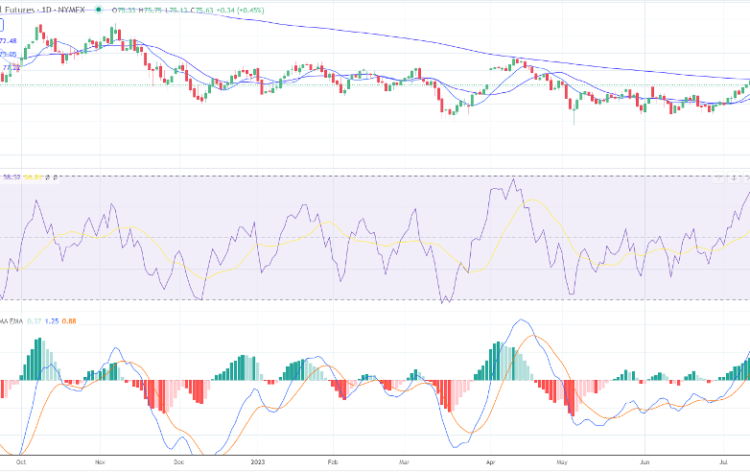Fossil Fuel Prices Bull Back as China Growth Disappoints

Petroleum prices have been rangebound, trading below resistance near the 200-day moving average (see chart). Concerns over Chinese economic growth continue to generate headwinds for oil, Brent, gasoline, and diesel fuel. Chinese economic growth, reflected by the Gross Domestic Product report, increased by 0.8% quarter over quarter in June, down from the 2.2% reported by the Chinese government in Q1. For the 12 months ending June 2023, Chinese GDP grew at 6.3%, up from the 4.5% seen in Q1 but well below economists’ forecasts that the world’s second-largest economy would grow by 7.3% year over year.
China is one of the largest consumers and importers of petroleum products, and the decline in growth prospects has weighed on energy prices. China continues to suffer from the lockdown set in place during the pandemic. Any boost the Chinese government expected to receive from the post-COVID boom has now faltered and will likely take additional stimulus from the People’s Bank of China to help buoy Chinese GDP. To help ease the burden China undergoes to import significant oil and natural gas volumes, China is undergoing an energy transition.
What Else is Going On In China
Some additional economic data released in the latter part of July shows that GDP could continue to slide. June Retail Sales in China increased by 3.1%, slowing from 12.7% in May. Private fixed asset investment declined to 0.2% in H1 2023 compared to an 8.1% expansion seen by the Chinese States seen during the same period. The lackluster data will likely generate fiscal expansion from the Chinese government to buoy economic growth.
Fiscal Expansion Compared to Monetary Policy
Fiscal expansion refers to the implementation of policies by the government to stimulate economic growth and increase aggregate demand in an economy. It typically involves increasing government spending and reducing taxes to boost consumer and business spending. The fiscal expansion aims to stimulate economic activity, create jobs, and accelerate economic growth during periods of economic downturn or slow growth. By injecting more money into the economy, the government aims to stimulate consumption and investment, ultimately contributing to economic recovery.
Monetary policy easing refers to a central bank’s measures to stimulate economic growth and encourage borrowing and spending. It typically involves reducing interest rates, making borrowing cheaper for businesses and individuals.
By lowering interest rates, central banks aim to increase the amount of money in circulation, making it easier for businesses to borrow and invest, which can stimulate economic activity. Monetary policy easing can also involve other measures, such as quantitative easing, where a central bank buys financial assets to inject even more money into the economy. The goal of monetary policy easing is to encourage spending and investment, which can help boost economic growth and combat inflationary pressures.
How Does Lower Grow Weigh on Oil Prices?
When GDP declines, it typically indicates a slowdown or contraction in the economy. This information can have a direct impact on the oil demand.
During an economic downturn, businesses and industries tend to scale back production and reduce their energy consumption, which leads to a decrease in oil demand. This phenomenon reduces the need and then puts downward pressure on oil prices. Consumers may also reduce discretionary spending, including travel, reducing crude oil investing demand for oil products like gasoline and aviation fuel.
Furthermore, a decline in GDP can often be associated with decreased economic activity globally. This scenario can result in reduced international trade and weaker demand for oil from other countries, contributing to the downward movement in oil prices.
It’s important to note that geopolitical events, production levels, and supply and demand dynamics can influence oil prices. However, during a GDP decline, the reduced economic activity and lower demand for oil products significantly push oil prices.
What Can China Do to Boost Demand
China has several paths it can take. The Chinese government can implement policies to increase government spending or cut taxes, boosting aggregate demand and stimulating economic activity. China could focus on implementing structural reforms to address inefficiencies in the economy. China can engage in further infrastructure investment. Continued investment in infrastructure projects can stimulate economic growth by creating jobs, improving connectivity, and attracting private investment. China could further invest in research and development, fostering technological advancements to drive productivity gains and promote innovation in critical industries. Further opening up China’s markets to foreign investment and trade can encourage competition, attract capital and expertise, and drive economic growth.
Who in China Can Reduce Interest Rates?
The People’s Bank of China (is the central bank of the People’s Republic of China. It serves as the monetary authority responsible for conducting monetary policy, issuing and regulating the Chinese currency, the yuan, and maintaining financial stability in the country. The PBOC is crucial in managing China’s monetary supply, interest rates, and foreign exchange reserves. It also supervises the banking system and oversees financial institutions in China.
Does China Import Oil
China has been one of the largest importers of oil in the world. In 2021 China was the second largest importer of crude oil globally, importing about 12.7 million barrels daily. Only Europe imports more crude oil than China.
China imports oil for several reasons. China is the world’s largest energy consumer, and its domestic oil production is insufficient to meet its growing demand. Therefore, importing oil allows China to fulfill its energy needs and support its economic growth.
China imports oil to diversify its energy sources. By relying on imported oil, China reduces its dependence on a single energy supplier or region, which helps enhance energy security. Additionally, China imports oil to supplement its refining capacity. Although China has a significant refining industry, it may still import specific grades of crude oil that are not readily available domestically or are more cost-effective to import.
China’s oil imports also support its strategic reserves program. By stockpiling oil, China aims to ensure a stable supply in case of emergencies or disruptions in global oil markets. Overall, importing oil enables China to meet its energy demands, diversify its energy sources, and secure its energy supply for economic and strategic purposes.
China Imports Other Fossil Fuels
China also imports natural gas. Like its oil imports, China’s domestic natural gas production cannot meet its growing demand. As a result, China relies on imports to supplement its gas supply. China’s natural gas imports have increased rapidly in recent years due to its efforts to reduce coal consumption and combat air pollution. China has been actively importing liquefied natural gas and pipeline gas from Australia, Russia, Qatar, and Myanmar to diversify its energy sources and reduce reliance on coal. Importing natural gas helps China meet its energy needs and supports its goals of reducing carbon emissions and transitioning to cleaner energy sources.
China is Undergoing an Energy Transition
China is attempting to mitigate its exposure to fossil fuels by undergoing an energy transition. China is currently undergoing a transportation energy transition. Over the past few years, the Chinese government has been actively promoting the adoption of electric vehicles to reduce dependence on fossil fuels and combat air pollution. China is now the world’s largest market for electric cars, with a significant share of global EV sales.
The Chinese government has implemented various policies and incentives to encourage the production and use of electric vehicles. These include EV purchase subsidies, charging infrastructure investments, and tighter car emissions standards. Additionally, China has set quotas for automakers to produce a certain percentage of electric vehicles, aiming to promote the development of the domestic electric vehicle industry.
In addition to promoting electric vehicles, China is also exploring other transportation energy alternatives. For instance, the country has been investing in hydrogen fuel cell technology and promoting using hydrogen fuel cell vehicles. Furthermore, China has significantly advanced in developing and implementing advanced transportation systems, such as high-speed rail networks, to improve overall energy efficiency and reduce emissions. China’s transportation energy transition is driven by reducing reliance on fossil fuels, cutting emissions, and promoting sustainable transportation solutions.
The Bottom Line
The upshot is that the decline in Chinese growth has capped the upward momentum in petroleum and natural gas prices. Reducing Chinese growth has limited oil demand and reduced the need for natural gas. To combat the decline in GDP, the Chinese central bank has started considering reducing interest rates to help stimulate economic growth. The next step will be fiscal stimulus from the Chinese government to help buoy demand. While Chinese data continues to show some weakness, easing monetary policy and budgetary solid stimulus will likely drive demand and buoy imports of fossil fuels.






















Comments (0 comment(s))